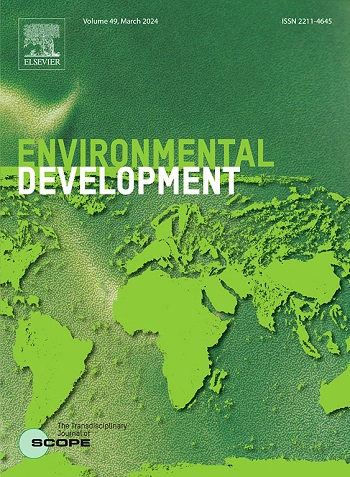Impact of rural credit on sustainable transformation of Brazilian agriculture: The case of the Low Carbon Agriculture (LCA) Program in Minas Gerais, Brazil
IF 5.3
2区 环境科学与生态学
Q2 ENVIRONMENTAL SCIENCES
引用次数: 0
Abstract
In Brazil, changes in land use and forests are responsible for more than 70 % of CO2 equivalent emissions. The federal administration created, in 2011, the Low Carbon Agriculture (LCA) Program of rural credit, to finance climate change mitigation and adaptation technologies. Thus, the hypothesis of this work understands that rural credit from the LCA Program was capable, over 8 years, of expanding the adoption of sustainable agricultural practices and, thus, positively impacting land use and occupation in the state of Minas Gerais, Brazil. Therefore, the objectives of this work were: (i) to establish relationships between the rural credit flow of the LCA Program and municipal agricultural practices in Minas Gerais; and (ii) to determine the impact of the LCA Program on the adoption of mitigation technologies and land use in Minas Gerais, for the 2013–2020 time series. The results of this study showed that the municipalities with access to LCA Program credit were those with higher agricultural activity and a greater extent of degraded pasture areas. On average, these municipalities had 0.39 km2 of silviculture area, compared to 0.12 km2 in those without access, and 58.8 cattle per producer, versus 34.9 in non-beneficiary areas. They also concentrated 16.5 % of degraded pastures, while municipalities without credit had 9.6 %. Between 2013 and 2020, there was a 41 % reduction in intermediately degraded pastures and a 13.4 % increase in non-degraded pastures across the state. Thus, it can be concluded that LCA Program credit was statistically relevant for areas in need of recovery, contributing to improved pasture quality and more efficient land use in Minas Gerais. The findings highlight the role of targeted rural credit as a key mechanism to drive and enable land use transitions in agriculture toward more resilient systems adapted to future climate instabilities.
农村信贷对巴西农业可持续转型的影响:以巴西米纳斯吉拉斯州低碳农业项目为例
在巴西,土地利用和森林的变化占二氧化碳当量排放量的70%以上。联邦政府于2011年创建了低碳农业(LCA)农村信贷计划,为减缓和适应气候变化的技术提供资金。因此,这项工作的假设是,LCA项目的农村信贷能够在8年的时间里扩大可持续农业实践的采用,从而对巴西米纳斯吉拉斯州的土地使用和占用产生积极影响。因此,这项工作的目标是:(i)建立LCA计划的农村信贷流动与米纳斯吉拉斯州市政农业实践之间的关系;(二)确定2013-2020年期间LCA方案对米纳斯吉拉斯州采用缓解技术和土地利用的影响。本研究结果表明,获得LCA计划信贷的城市是那些农业活动较高和牧场退化程度较大的城市。平均而言,这些城市的造林面积为0.39平方公里,而没有森林的城市为0.12平方公里,每个生产者有58.8头牛,而非受益地区为34.9头。他们还集中了16.5%的退化牧场,而没有信贷的自治市则集中了9.6%。2013年至2020年间,全州中度退化牧场减少了41%,未退化牧场增加了13.4%。因此,可以得出结论,LCA计划信贷与需要恢复的地区具有统计相关性,有助于改善米纳斯吉拉斯州的牧场质量和更有效的土地利用。研究结果强调了有针对性的农村信贷作为一种关键机制的作用,可以推动并使农业土地利用转型为适应未来气候不稳定的更具弹性的系统。
本文章由计算机程序翻译,如有差异,请以英文原文为准。
求助全文
约1分钟内获得全文
求助全文
来源期刊

Environmental Development
Social Sciences-Geography, Planning and Development
CiteScore
8.40
自引率
1.90%
发文量
62
审稿时长
74 days
期刊介绍:
Environmental Development provides a future oriented, pro-active, authoritative source of information and learning for researchers, postgraduate students, policymakers, and managers, and bridges the gap between fundamental research and the application in management and policy practices. It stimulates the exchange and coupling of traditional scientific knowledge on the environment, with the experiential knowledge among decision makers and other stakeholders and also connects natural sciences and social and behavioral sciences. Environmental Development includes and promotes scientific work from the non-western world, and also strengthens the collaboration between the developed and developing world. Further it links environmental research to broader issues of economic and social-cultural developments, and is intended to shorten the delays between research and publication, while ensuring thorough peer review. Environmental Development also creates a forum for transnational communication, discussion and global action.
Environmental Development is open to a broad range of disciplines and authors. The journal welcomes, in particular, contributions from a younger generation of researchers, and papers expanding the frontiers of environmental sciences, pointing at new directions and innovative answers.
All submissions to Environmental Development are reviewed using the general criteria of quality, originality, precision, importance of topic and insights, clarity of exposition, which are in keeping with the journal''s aims and scope.
 求助内容:
求助内容: 应助结果提醒方式:
应助结果提醒方式:


